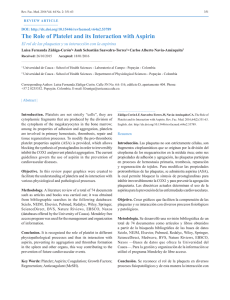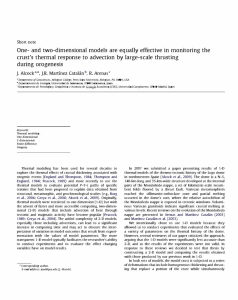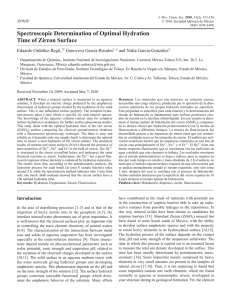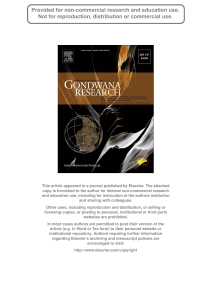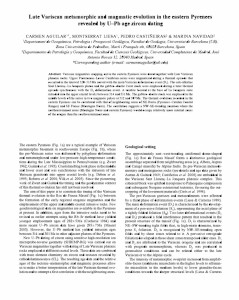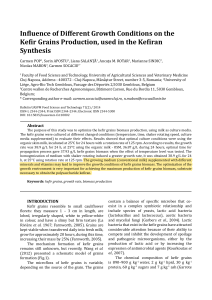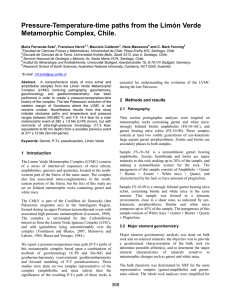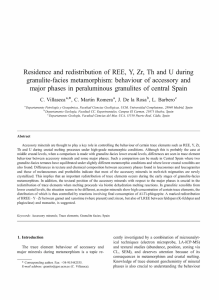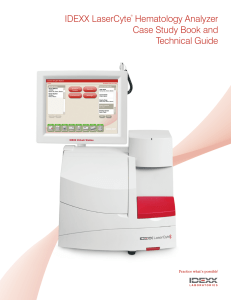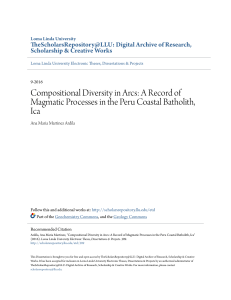Halliday, A.N., In the beginning..., Nature, 409, 144
Anuncio
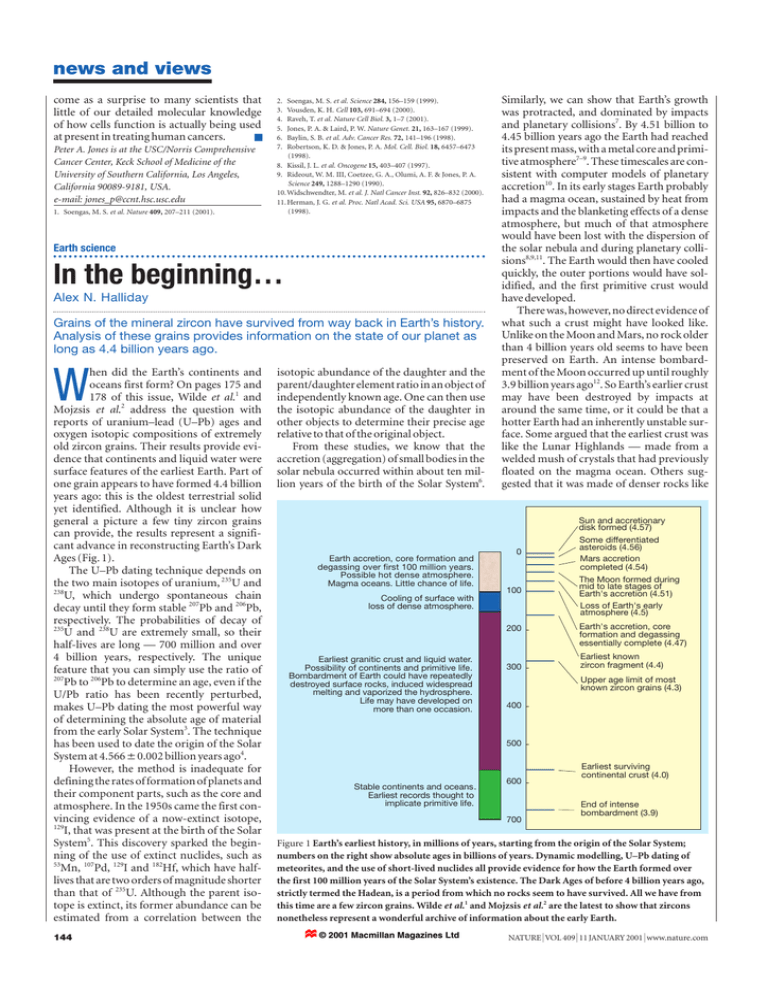
news and views come as a surprise to many scientists that little of our detailed molecular knowledge of how cells function is actually being used at present in treating human cancers. ■ Peter A. Jones is at the USC/Norris Comprehensive Cancer Center, Keck School of Medicine of the University of Southern California, Los Angeles, California 90089-9181, USA. e-mail: [email protected] 1. Soengas, M. S. et al. Nature 409, 207–211 (2001). 2. 3. 4. 5. 6. 7. Soengas, M. S. et al. Science 284, 156–159 (1999). Vousden, K. H. Cell 103, 691–694 (2000). Raveh, T. et al. Nature Cell Biol. 3, 1–7 (2001). Jones, P. A. & Laird, P. W. Nature Genet. 21, 163–167 (1999). Baylin, S. B. et al. Adv. Cancer Res. 72, 141–196 (1998). Robertson, K. D. & Jones, P. A. Mol. Cell. Biol. 18, 6457–6473 (1998). 8. Kissil, J. L. et al. Oncogene 15, 403–407 (1997). 9. Rideout, W. M. III, Coetzee, G. A., Olumi, A. F. & Jones, P. A. Science 249, 1288–1290 (1990). 10. Widschwendter, M. et al. J. Natl Cancer Inst. 92, 826–832 (2000). 11. Herman, J. G. et al. Proc. Natl Acad. Sci. USA 95, 6870–6875 (1998). Earth science In the beginning… Alex N. Halliday Grains of the mineral zircon have survived from way back in Earth’s history. Analysis of these grains provides information on the state of our planet as long as 4.4 billion years ago. hen did the Earth’s continents and oceans first form? On pages 175 and 178 of this issue, Wilde et al.1 and Mojzsis et al.2 address the question with reports of uranium–lead (U–Pb) ages and oxygen isotopic compositions of extremely old zircon grains. Their results provide evidence that continents and liquid water were surface features of the earliest Earth. Part of one grain appears to have formed 4.4 billion years ago: this is the oldest terrestrial solid yet identified. Although it is unclear how general a picture a few tiny zircon grains can provide, the results represent a significant advance in reconstructing Earth’s Dark Ages (Fig. 1). The U–Pb dating technique depends on the two main isotopes of uranium, 235U and 238 U, which undergo spontaneous chain decay until they form stable 207Pb and 206Pb, respectively. The probabilities of decay of 235 U and 238U are extremely small, so their half-lives are long — 700 million and over 4 billion years, respectively. The unique feature that you can simply use the ratio of 207 Pb to 206Pb to determine an age, even if the U/Pb ratio has been recently perturbed, makes U–Pb dating the most powerful way of determining the absolute age of material from the early Solar System3. The technique has been used to date the origin of the Solar System at 4.56650.002 billion years ago4. However, the method is inadequate for defining the rates of formation of planets and their component parts, such as the core and atmosphere. In the 1950s came the first convincing evidence of a now-extinct isotope, 129 I, that was present at the birth of the Solar System5. This discovery sparked the beginning of the use of extinct nuclides, such as 53 Mn, 107Pd, 129I and 182Hf, which have halflives that are two orders of magnitude shorter than that of 235U. Although the parent isotope is extinct, its former abundance can be estimated from a correlation between the W 144 isotopic abundance of the daughter and the parent/daughter element ratio in an object of independently known age. One can then use the isotopic abundance of the daughter in other objects to determine their precise age relative to that of the original object. From these studies, we know that the accretion (aggregation) of small bodies in the solar nebula occurred within about ten million years of the birth of the Solar System6. Earth accretion, core formation and degassing over first 100 million years. Possible hot dense atmosphere. Magma oceans. Little chance of life. Similarly, we can show that Earth’s growth was protracted, and dominated by impacts and planetary collisions7. By 4.51 billion to 4.45 billion years ago the Earth had reached its present mass, with a metal core and primitive atmosphere7–9. These timescales are consistent with computer models of planetary accretion10. In its early stages Earth probably had a magma ocean, sustained by heat from impacts and the blanketing effects of a dense atmosphere, but much of that atmosphere would have been lost with the dispersion of the solar nebula and during planetary collisions8,9,11. The Earth would then have cooled quickly, the outer portions would have solidified, and the first primitive crust would have developed. There was, however, no direct evidence of what such a crust might have looked like. Unlike on the Moon and Mars, no rock older than 4 billion years old seems to have been preserved on Earth. An intense bombardment of the Moon occurred up until roughly 3.9 billion years ago12. So Earth’s earlier crust may have been destroyed by impacts at around the same time, or it could be that a hotter Earth had an inherently unstable surface. Some argued that the earliest crust was like the Lunar Highlands — made from a welded mush of crystals that had previously floated on the magma ocean. Others suggested that it was made of denser rocks like 0 100 Cooling of surface with loss of dense atmosphere. 200 Earliest granitic crust and liquid water. Possibility of continents and primitive life. Bombardment of Earth could have repeatedly destroyed surface rocks, induced widespread melting and vaporized the hydrosphere. Life may have developed on more than one occasion. 300 Sun and accretionary disk formed (4.57) Some differentiated asteroids (4.56) Mars accretion completed (4.54) The Moon formed during mid to late stages of Earth's accretion (4.51) Loss of Earth's early atmosphere (4.5) Earth's accretion, core formation and degassing essentially complete (4.47) Earliest known zircon fragment (4.4) Upper age limit of most known zircon grains (4.3) 400 500 Stable continents and oceans. Earliest records thought to implicate primitive life. 600 700 Earliest surviving continental crust (4.0) End of intense bombardment (3.9) Figure 1 Earth’s earliest history, in millions of years, starting from the origin of the Solar System; numbers on the right show absolute ages in billions of years. Dynamic modelling, U–Pb dating of meteorites, and the use of short-lived nuclides all provide evidence for how the Earth formed over the first 100 million years of the Solar System’s existence. The Dark Ages of before 4 billion years ago, strictly termed the Hadean, is a period from which no rocks seem to have survived. All we have from this time are a few zircon grains. Wilde et al.1 and Mojzsis et al.2 are the latest to show that zircons nonetheless represent a wonderful archive of information about the early Earth. © 2001 Macmillan Magazines Ltd NATURE | VOL 409 | 11 JANUARY 2001 | www.nature.com news and views those of the Earth’s present ocean floor. But firm evidence was scarce. In 1983, with the exciting report13 of zircon grains over 4 billion years old, we at last had some evidence. But it upheld neither of the above theories. Instead the data constituted evidence that the early crust was like the continental crust today. The original host rocks for the zircons had been destroyed by erosion. But zircon is especially hard and enduring, and the grains survived to tell their tale after becoming incorporated in sedimentary rocks now exposed in Australia. The U–Pb ages of most of the grains turned out to be between 4.1 and 4.2 billion years, with a few grains being slightly older13,14. But why does the presence of zircons suggest the existence of continental crust? Nearly all zircons grow from granite magmas, which are nothing like those forming the ocean floor or Lunar Highlands. Such magmas usually form at high temperatures and depths of more than 20 km, mainly by melting of preexisting continental crust above the subduction zones where ocean crust is being dragged down into Earth’s mantle. But the granites are buoyant, and rise up to eventually create mountain regions such as the Andes. So the zircons described in the new papers1,2 are consistent with the existence of continental crust as far back as 4.4 billion years ago. We could do with more data to confirm this age, and inferring the existence of entire continents from zircon grains requires quite a leap of the imagination. Nonetheless, large ocean islands such as Iceland contain small amounts of granitic magma, and one can conceive of that magma acting as a nucleus for other material to accrete and create a proto-continent, and then a continent. Both Wilde et al.1 and Mojzsis et al.2 also include oxygen-isotope evidence for the presence of liquid water on the early Earth’s surface. The oxygen isotopic composition of zircons reflects that of the magma from which they crystallized, which in turn reflects the composition of the rocks that were melted to form the magma. Heavy oxygen (with a high proportion of the isotope 18O) is produced by low-temperature interactions between a rock and liquid water. The zircons are rich in heavy oxygen, which implies that the rocks that were melted to form the magma included components that had been at the surface in the presence of liquid water. Earlier on, when Earth was hotter, they might also have formed by melting of once-wet ocean-floor rocks during a process akin to modern subduction. Either way, surface rocks affected by low-temperature fluids were probably being transported to considerable depths and melted. However, there will be suspicions that the 18O-rich composition was acquired by diffusion after the zircons had been formed, so further information on that possibility is required. Zircon grains have further potential in NATURE | VOL 409 | 11 JANUARY 2001 | www.nature.com investigations of the early Earth. For example, Wilde et al.1 also analysed trace elements and tiny inclusions to reconstruct the composition of the parent magma, and Hf isotopes can be used to investigate the even earlier history of the Earth15. And zircons might even contain some isotopic or chemical tracer for early biological activity. For studies such as these we need more grains, and lots of them. ■ Alex N. Halliday is in the Department of Earth Sciences, ETH Zürich, NO C61, Sonneggstrasse 5, CH-8092 Zürich, Switzerland. e-mail: [email protected] 1. Wilde, S. A., Valley, J. W., Peck, W. H. & Graham, C. M. Nature 409, 175–178 (2001). 2. Mojzsis, S. J., Harrison, T. M. & Pidgeon, R. T. Nature 409, 178–181 (2001). 3. Patterson, C. C. Geochim. Cosmochim. Acta 10, 230–237 (1956). 4. Allègre, C. J., Manhès, G. & Göpel, C. Geochim. Cosmochim. Acta 59, 1445–1456 (1995). 5. Reynolds, J. H. Phys. Rev. Lett. 4, 8 (1960). 6. Lugmair, G. W. & Shukolyukov, A. Geochim. Cosmochim. Acta 62, 2863–2886 (1998). 7. Halliday, A. N. Earth Planet. Sci. Lett. 176, 17–30 (2000). 8. Sasaki, S. & Nakazawa, K. J. Geophys. Res. 91, B9231–B9238 (1986). 9. Porcelli, D., Cassen, P., Woolum, D. & Wasserburg, G. J. LPI Contrib. 597 35–36 (Lunar & Planetary Inst., Houston, 1998). 10. Wetherill, G. W. Annu. Rev. Astron. Astrophys. 18, 77–113 (1980). 11. Benz, W. & Cameron, A. G. W. in Origin of the Earth (eds Newsom, H. E. & Jones, J. H.) 61–67 (Oxford Univ. Press, 1990). 12. Wasserburg, G. J., Papanastassiou, D. A., Tera, F. & Huneke, J. C. Phil. Trans. R. Soc. Lond. A 285, 7–22 (1977). 13. Froude, D. O. et al. Nature 304, 616–618 (1983). 14. Compston, W. & Pidgeon, R. T. Nature 321, 766–769 (1986). 15. Amelin, Y. et al. Nature 399, 252–255 (1999). Cardiovascular biology Small cells, big issues Skip Brass Identification of a long-sought ADP receptor on platelets explains the effects of two drugs used to prevent strokes and heart attacks. It also points the way to developing other such drugs. latelets are the smallest of the human blood cells, measuring about one-tenth the diameter of a white blood cell. They usually circulate freely, maintained in a mobile but inactive state by molecules secreted or expressed by the endothelial cells that line the walls of blood vessels. Beneath the endothelial cells is a protein matrix that includes collagen fibres. When a vessel wall is damaged by injury or disease, platelets adhere to the newly exposed collagen fibres and become active, spreading themselves along the fibres in an effort to close the gap in the layer of endothelial cells (Fig. 1, over). This process — together with the formation of a clot comprising the blood protein fibrinogen — is responsible for stopping bleeding from wounds. At first, platelet activation depends on the presence of collagen and a blood protein called von Willebrand factor. But as platelets accumulate at the site of injury, further activation and the growth of the platelet plug become increasingly dependent on ADP, secreted from platelets or released from damaged red blood cells. To accomplish all this in a timely fashion, platelets express on their surface a dense array of receptors for molecules, such as ADP, that trigger platelet activation. The molecular identity of two of the ADP receptors is well known. But pharmacological evidence indicated that there must be a third — and, on page 202 of this issue1, Hollopeter and colleagues identify this hitherto elusive receptor. Much of the recent work on platelet biology has looked at how platelet activation begins — that is, how non-sticky cells circulating in the bloodstream are transformed into highly sticky ones that adhere to collagen P © 2001 Macmillan Magazines Ltd fibres. This is not a trivial issue. Like many human defence mechanisms, optimal platelet responsiveness represents a balance between too much and too little. A platelet must be activated within seconds of approaching a damaged site, or bleeding will continue. On the other hand, overly responsive platelets could block normal blood flow in the smaller vessels of the heart and brain, particularly at sites where atherosclerosis — the deposition of cholesterol-laden plaques — has narrowed the vessel lumen and damaged the protective layer of endothelial cells. Hence the strong interest in identifying platelet-activating receptors that might serve as targets for drugs designed to prevent the unwanted formation of platelet plugs. Most of these receptors are coupled to intracellular signalling pathways by molecular switches called G proteins. Human platelets express at least ten G proteins, and each type of receptor can couple to one or more types, initiating signalling through several pathways. Pharmacological evidence indicates that human platelets express at least three different types of ADP receptor2–4. One type, designated P2Y1, was thought to be coupled to platelet activation through members of the Gq family of G proteins. This receptor was predicted to be largely responsible for the increase in the concentration of calcium ions inside platelets that is needed to support platelet activation. Indeed, such a role has been confirmed by inactivating the genes encoding P2Y1 (refs 5, 6) and Gq (ref. 7) in mice. The second receptor — P2X1 — is a calcium channel, but its contribution to the activation of platelets by ADP has recently 145

